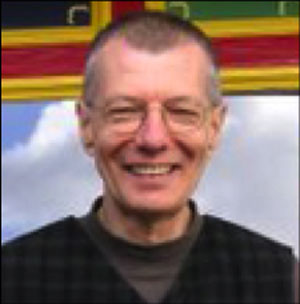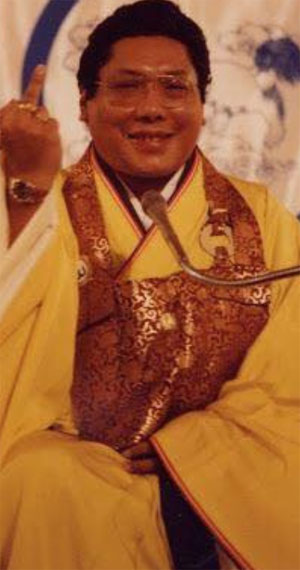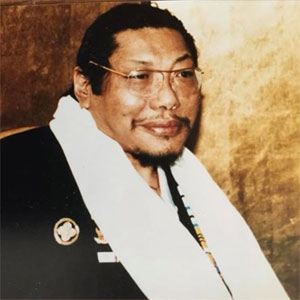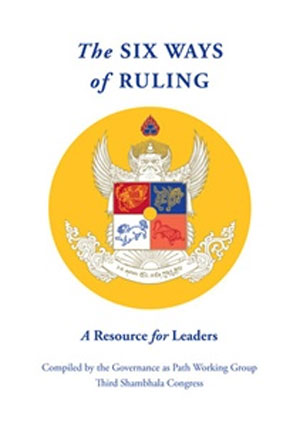The Drala Principleby Bill Scheffel
westernmountain.org
Accessed: 6/29/19
NOTICE: THIS WORK MAY BE PROTECTED BY COPYRIGHTYOU ARE REQUIRED TO READ
THE COPYRIGHT NOTICE AT THIS LINK BEFORE YOU READ THE FOLLOWING WORK, THAT IS AVAILABLE SOLELY FOR PRIVATE STUDY, SCHOLARSHIP OR RESEARCH PURSUANT TO 17 U.S.C. SECTION 107 AND 108. IN THE EVENT THAT THE LIBRARY DETERMINES THAT UNLAWFUL COPYING OF THIS WORK HAS OCCURRED, THE LIBRARY HAS THE RIGHT TO BLOCK THE I.P. ADDRESS AT WHICH THE UNLAWFUL COPYING APPEARED TO HAVE OCCURRED. THANK YOU FOR RESPECTING THE RIGHTS OF COPYRIGHT OWNERS.
We may have been interested in our world when we were little children, but then we were taught how to handle it by our parents who had already developed a system to deal with the world and to shield themselves from it at the same time. As we accepted that system, we lost contact with the freshness and curiosity of experience. -- Chögyam Trungpa.
Introduction to the Drala PrincipleThe “drala principle” refers to a body of teachings the Tibetan Buddhist meditation master Chögyam Trungpa presented in the last decade of his life, from 1978 to 1986.
The roots of the drala principle precede the introduction of Buddhism into Tibet and are found in the indigenous traditions of that country -- as they are in all countries. The drala principle is applicable, not to Buddhist practitioners alone, but to anyone. These teachings speak to the heart, whether one is, so to speak, religiously, artistically or politically motivated.
Drala is the elemental presence of the world that is available to us through sense perceptions.
When we open to trees, flowers, a creek or clouds we encounter an actual wisdom, though one that is not separate from our own.
Beholding a river is much more than merely looking at a river; potentially, we are meeting the dralas. A friend of mine was once with her family in upstate New York. It was winter and they had hiked into a forest. The landscape was one of cold and snow, whiteness and silence, birch trees. Astonished by the pristine beauty, my friend realized it was her duty -- not just to notice this beauty -- but to stop and linger with it. To
let it penetrate her. To listen. We have failed to see
our first responsibility to the world is an aesthetic one.
In the drala teachings,
each of the senses is considered an “unlimited field of perception” in which there are sights, sounds and feelings “we have never experienced before” –- no one has ever experienced!
Each sense moment, if we are present for it, is a gate into the elemental wisdom of the world, even a cold sip of coffee could ignite the experience of Yeats: “While on the shop and street I gazed / My body of a sudden blazed.”
Every perception is a pure perception; from the feel of a meager pebble stuck in our shoe to the meow of a house cat. Through this kind of perception we discover that we live in a vast,
singular and unexplored world.
To make a stone stonier, that is the purpose of art.
-- Viktor Shklovski
Sometimes a stone, a tree, a teacup or a violin processes
an intangible presence, a numinousity, that cannot be explained.
Ever since man first
painted animals in the dark of caves he has been responding to
the holy, to the numinous, to the mystery of being and becoming, to what Goethe very aptly called "the weird portentous." Something inexpressible was felt to lie behind nature. The bear cult, circumpolar in distribution and known archaeologically to extend into Neanderthal times, is a further and most ancient example. The widespread beliefs in descent from a totemic animal, guardian helpers in the shapes of animals, the concept of the game lords who released or held back game to man are all part of a variety of a sanctified, reverent experience that extends from the beautiful rock paintings of South Africa to the men of the Labradorean forests or the Plains Indian seeking by starvation and isolation to bring the sacred spirits to his assistance. All this is part of the human inheritance, the wonder of the world, and nowhere does that wonder press closer to us than in the guise of animals which, whether supernaturally as in the caves of our origins or, as in Darwin's sudden illumination, perceived to be, at heart, one form, one awe-inspiring mystery, seemingly diverse and apart but derived from the same genetic source. Thus the mysterium arose not by primitive campfires alone.
-- The Star Thrower, by Loren Eiseley
George Dorn was listening to a different kind of chorus. It was, Mavis had explained to him in advance, the weekly Agape Ludens, or Love Feast Game, of
the Discordians, and the dining hall was newly bedecked with pornographic and psychedelic posters, Christian and Buddhist and Amerindian mystic designs, balloons and lollypops dangling from the ceiling on Day-Glo-dabbed strings,
numinous paintings of Discordian saints (including Norton I, Sigismundo Malatesta, Guillaume of Aquitaine, Chuang Chou, Judge Roy Bean, various historical figures even more obscure, and numerous gorillas and dolphins), bouquets of roses and forsythia and gladiolas and orchids, clusters of acorns and gourds, and the inevitable proliferation of golden apples, pentagons and octopi.
-- The Illuminatus! Trilogy, by Robert Shea and Robert Anton Wilson
One thing, anyway, cannot be doubted:
Christ is a highly numinous figure. The interpretation of him as God and the son of God is in full accord with this.
-- Answer to Job, by C.G. Jung
[T]here is every likelihood that
the numinous qualities which make the mother-imago so dangerously powerful derive from the collective archetype of the anima, which is incarnated anew in every male child.
-- Aion, by C.G. Jung
In all the rituals of the Highest Tantra initiations a symbolic female sacrifice is set in scene. From numerous case studies in cultural and religious history we are aware that an “archaic first event”, an “inaugural sacred murder” may be hiding behind such symbolic stagings. This “original event”, in which a real wisdom consort was ritually killed, need in no sense be consciously acknowledged by the following generations and cult participants who only perform the sacrifice in their imaginations or as holy theater. As the French anthropologist René Girard convincingly argues in his essay on Violence and the Sacred, the original murderous deed is normally no longer fully recalled during later symbolic performances. But it can also not become totally forgotten.
It is important that the violent origin of their sacrificial rite be shrouded in mystery for the cult participant. “To maintain its structural force, the inaugural violence must not make an appearance”, claims Girard (Girard, 1987, p. 458). Only thus can the participants experience that particular emotionally laden and ambivalent mixture of crime and mercy, guilt and atonement, violence and satisfaction, shuddering and repression which first lends the numinous aura of holiness to the cult events.-- The Shadow of the Dalai Lama: Sexuality, Magic and Politics in Tibetan Buddhism, by Victor and Victoria Trimondi
The presence might not always be there, or only be there for a short period of time, but that presence may refer to another dimension of the drala principle. Just as our tangible world is populated -- and sometimes densely populated -- with people and other sentient creatures,
the intangible or "invisible world" (invisible to most of us) is densely populated as well, and among these beings, entities, or spirits are classes of beings, or qualities of being, called dralas. Katumblies, kachinas, kami, gnomes, elves, angels, gods. Any being who acts on behalf of the non-dualistic and compassionate nature of existence could be considered a drala. The dralas are not really part of some other world, but latent everywhere. The dralas, as Chögyam Trungpa so often said, want very much to meet us.
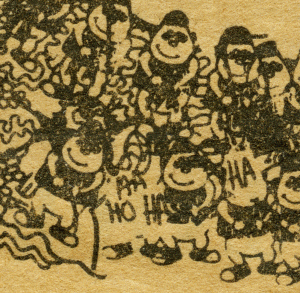 HA HA HA HO
HA HA HA HOWILLIAM JAMES SAID:
OUR NORMAL WAKING CONSCIOUSNESS
IS BUT ONE SPECIAL TYPE OF CONSCIOUSNESS
WHILST ALL ABOUT IT
PARTED FROM IT BY THE FILMIEST OF SCREENS
THERE LIE
POTENTIAL FORMS OF CONSCIOUSNESS ENTIRELY DIFFERENT
WE MAY GO THROUGH LIFE
WITHOUT SUSPECTING THEIR EXISTENCE
BUT APPLY THE REQUISITE STIMULUS AND AT A TOUCH
THEY ARE THERE IN ALL THEIR COMPLETENESS
DEFINITE TYPES OF MENTALITY WHICH PROBABLY SOMEWHERE
HAVE THEIR FIELD OF APPLICATION AND ADAPTATION
NO ACCOUNT OF THE UNIVERSE IN ITS TOTALITY
CAN BE FINAL WHICH LEAVES THESE OTHER FORMS
OF CONSCIOUSNESS QUITE DISREGARDED.
HOW TO REGARD THEM IS THE QUESTION
FOR THEY ARE SO DISCONTINUOUS WITH ORDINARY
CONSCIOUSNESS. THEY MAY DETERMINE
ATTITUDES, THOUGH THEY CANNOT FURNISH FORMULAS
AND OPEN A REGION THOUGH THEY FAIL TO GIVE A MAP.
AT ANY RATE, CONCLUDES JAMES,
THEY FORBID OUR PREMATURE CLOSING OF ACCOUNTS
WITH REALITY
IN SPITE OF WHAT HE SAID
WE'VE CLOSED OUR ACCOUNTS WITH REALITY
(MOST OF US)
-- Be Here Now, by "Ram Dass," aka The Lama Foundation
We find, in the next place, the doctrine of Elemental spirits. "When you shall be numbered among the Children of the philosophers," says the "Comte de Gabalis," "and when your eyes shall have been strengthened by the use of the most sacred medecine, you will learn that the Elements are inhabited by creatures of a singular perfection, from the knowledge of, and communication with, whom the sin of Adam has deprived his most wretched posterity. Yon vast space stretching between earth and Heaven has far nobler dwellers than the birds and the gnats; these wide seas hold other guests than the whales and the dolphins; the depths of the earth are not reserved for the moles alone; and that element of fire which is nobler than all the rest was not created to remain void and useless." According to Paracelsus, "the Elementals are not spirits, because they have flesh, blood, and bones; they live and propagate offspring; they eat and talk, act and sleep, &c.... They are beings occupying a place between men and spirits, resembling men and women in their organisation and form, and resembling spirits in the rapidity of their locomotion." They must not be confounded with the Elementaries which are the astral bodies of the dead. [2] They are divided into four classes. "The air is replete with an innumerable multitude of creatures, having human shapes, somewhat fierce in appearance, but docile in reality; great lovers of the sciences, subtle, serviceable to the Sages, and enemies of the foolish and ignorant. Their wives and daughters are beauties of the masculine type.... The seas and streams are inhabited even as the air; the ancient Sages gave the names of
Undines or Nymphs to these Elementals. There are few males among them, and the women are very numerous, and of extreme beauty; the daughters of men cannot compare with them. The earth is filled by gnomes even to its centre, creatures of diminutive size, guardians of mines, treasures, and precious stones. They furnish the Children of the Sages with all the money they desire, and ask little for their services but the distinction of being commanded. The gnomides, their wives, are tiny, but very pleasing, and their apparel is exceedingly curious. As to the Salamanders, those fiery dwellers in the realm of flame, they serve the Philosophers, but do not eagerly seek their company, and their wives and daughters are seldom visible. They transcend all the others in beauty, for they are natives of a purer element."
-- The Real History of the Rosicrucians, by Arthur Edward Waite
Hermetists called into being, out of the elements, the shapes of salamanders, gnomes, undines, and sylphs, which they did not pretend to create, but simply to make visible by holding open the door of nature, so that, under favoring conditions, they might step into view. For instance, if man has a preponderance of the Earthly, gnomic element, the gnomes will lead him towards assimilating metals — money and wealth, and so on.
--
The Secret Doctrine -- The Synthesis of Science, Religion, and Philosophy, by Helena Petrovna Blavatsky
The Cabiri are, in fact, the mysterious creative powers, the gnomes who work under the earth, i.e., below the threshold of consciousness, in order to supply us with lucky ideas. As imps and hobgoblins, however, they also lay all sorts of nasty tricks, keeping back names and dates that were 'on the tip of the tongue,' making us say the wrong thing, etc. They give an eye to everything that has not already been anticipated by consciousness and the functions at its disposal ... deeper insight will show that the primitive and archaic qualities of the inferior function conceal all sorts of significant relationships and symbolic meanings, and instead of laughing off the Cabiri as ridiculous Tom Thumbs he may begin to suspect that they are a treasure-house of hidden wisdom.
--
The Red Book: Liber Novus, by C.G. Jung
Using metaphors in the form of words, names and especially mantras or seed-syllables traditionally plays a central part in calling to the dralas, announcing our interest in meeting them, our availability. One example of the fertility of the drala principle is the Ganges River, perhaps historically home to the world's largest population of dralas! Itself a drala. This river, so long adored (and now like most rivers, so under siege by pollution and human disregard of its essential sacredness) traditionally has one-hundred and eight names, each of them a form of praise and, in that it speaks of a specific quality, the name of a drala(s) as well:
Visnu-padabja-sambhuta : Born from the lotus like foot of Visnu
Himancalendra-tanaya : Daughter of the Lord of Himalaya
Ksira-subhra : White as milk
Nataibhiti-hrt : Carrying away fear
Ramya : Delightful
Atula : Peerless
Japa Muttering : Whispering
Jagan-matr : Mother of what lives or moves
Discovering the DralasOn the most simple and immediate level, the moment-to-moment path of discovering the drala principle might follow these steps, which will be elaborated on in subsequent text.
• Each moment of perception can potentially be experienced as a moment of pure perception - experience not yet mediated through discursive thought and conceptual process. These moments are not yet conditioned by hope and fear, by our opinions, desires and beliefs. This immediate awareness of pure perception is “without choice, without demand, without anxiety”.
• Moments of pure perception are experiences of beauty expressed though specific details.
It is our duty to notice the details that call to us –- any taste, any sight, any sound. This is the call of the dralas.•
If we quiet our mind by opening to these details, and if we listen to the response of our heart, we may discover our moment-to-moment, day-to-day direction. Thus we begin to follow our heart, to live beyond conditioning – and to be led by the dralas. Not only is our heart the source of our direction in life, it is the source of our confidence.A Course of StudyBelow is a partial outline of some of the topics of study of the drala principle. Each topic is introduced and briefly described, often simply with a quote. (In teaching, I've shared these themes - and quotes - with hundreds of people. These words are old friends who I have shared with people who have become friends and who I am now sharing with new friends...)
Simply relaxThe experience of drala is as close as our own eyes, ears and tongue.
We don't have to try to taste, say, an orange,
we simply need to relax into the presence of the flavor on our tongue and the orange naturally begins to communicate with us. We are generally too active and our own business drowns out the messages of the world around us. To access the dralas we must do less and be more.
Give yourself a break. That doesn’t mean to say that you should drive to the closest bar and have lots to drink or go to a movie. Just enjoy the day, your normal existence. Allow yourself to sit in your home or take a drive into the mountains. Park your car somewhere; just sit; just be. It sounds very simplistic, but it has a lot of magic. You begin to pick up on clouds, sunshine and weather, the mountains, your past, your chatter with your grand-mother and your grandfather, your own mother, your own father. You begin to pick up on a lot of things. Just let them pass like the chatter of a brook as it hits the rocks. We have to give ourselves some time to be.
We’ve been clouded by going to school, looking for a job—our lives are cluttered by all sorts of things. Your friends want you to come have a drink with them, which you don’t want to do. Life is crowded with all sorts of garbage. In themselves, those things aren’t garbage, but they’re cumbersome when they get in the way of how to relax, how to be, how to trust, how to be a warrior. We’ve missed so many possibilities for that, but there are so many more possibilities that we can catch. We have to learn to be kinder to ourselves, much more kind. Smile a lot, although nobody is watching you smile. Listen to your own brook, echoing yourself. You can do a good job.
In the sitting practice of meditation, when you begin to be still, hundreds of thousands, millions, and billions of thoughts will go through your mind. But they just pass through, and only the worthy ones leave their fish eggs behind. We have to leave ourselves some time to be. You’re not going to see the Shambhala vision, you’re not even going to survive, by not leaving yourself a minute to be, a minute to smile. If you don’t grant yourself a good time, you’re not going to get any Shambhala wisdom, even if you’re at the top of your class technically speaking. Please, I beg you, please, give yourself a good time.
-- Chögyam Trungpa, from The Great Eastern Sun
Allow LimitationLimitation is the practice or discipline that supports being. Becoming receptive or open is a natural byproduct of limitation. Meditation is a quintessential act of limitation (though one shouldn't be hemmed in by preconceived ideas of what meditation is, or where or how it can occur!). Even watching a movie requires the limitation of remaining quiet and sitting still. There is, obviously, no better way possible to receive the experience of a movie (though the drala principle is a more interesting movie that costs nothing to see).
Accepting limitation is a conscious choice in which we have begun to realize the world becomes a far more interesting and abundant place if we limit ourselves.One tires of living in the country, and moves to the city; one tires of one's native land, and travels abroad; one tires of Europe and goes to America, and so on; finally one indulges in the sentimental hope of endless journeyings from star to star. Or the movement is different but still extensive. One tires of porcelain dishes and eats on silver; one tires of silver and turns to gold; one burns half of Rome to get an idea of the burning of Troy. But this method defeats itself, it is plain endlessness.
My own method does not consist in such a change of field, but rather resembles the true rotation method in changing the crop and the mode of cultivation, rather than the field.
Here we have the principle of limitation, the only saving principle in the world. The more you limit yourself, the more fertile you become in imagination. -- Soren Kiekegard
I embarked on two years of painting those paintings, two lines on each canvas, and at the end of two years there were ten of them. So I painted a total of twenty lines over a period of two years of very, very intense activity. I mean, I essentially spent twelve and fifteen hours a day in the studio, seven days a week. In fact I had no separation between by studio life and my outside life. There was no separation between me and those paintings...
I put myself in that disciplined position, and one of the tools I used was boredom. Boredom is a very good tool. Because whenever you play creative games, what you normally do is you bring to the situation all your aspirations, all your assumptions, all your ambitions - all your stuff. And then you pile it up on your painting, reading into the painting all the things you want it to be. I'm sure it's the same with writing; you load it up with all your illusions about what it is. Boredom's a great way to break that. You do the same thing over and over again until you're bored stiff with it. Then all your illusions, aspirations, everything just drains off. And now what you see is what you get.
-- Robert Irwin, from Seeing is Forgetting the Name of the Thing One Sees.
Become part of a LineageA lineage, as the word is used here, means any tradition that evokes and propagates drala. A painting, say, of Cezanne is loaded with drala. A man like Cezanne does not simply happen, but is someone who received the training and inspiration of countless ancestors before him and then put what he received into practice. That Cezanne apocryphally painted until his eyes bled is a measure of the work and sacrifice required to become a great lineage holder. Spiritual or religious lineages have no doubt produced our greatest lineage figures, but the path of drala cannot be defined as strictly sacred or secular. It could occur wherever genuine goodness and devotion are manifested. We might not even realize the lineages we are already part of; anyone who has ever read a poem has made contact with one of humanity's most universal, primordial and wonderful lineages.I found no grail. But I did discover the modern tradition. Because modernity is not a poetic school but a lineage, a family dispersed over several continents and which for two centuries has survived many sudden changes and misfortunes: public indifference, isolation, and tribunals in the name of religious, political, academic and sexual orthodoxy. Being a tradition and not a doctrine, it has been able to persist and to change at the same time. This is also why it is so diverse. Each poetic adventure is distinct, and each poet has sown a different plant in the miraculous forest of speaking trees. Yet if the poems are different and each path distinct, what is it that unites these poets? Not an aesthetic but a search.
-- Octavio Paz, 20th Century Mexican poet and Nobel Laureate.
Seek Victory over WarChögyam Trungpa initially translated Tibetan drala into an English compound word, wargod. He termed this "not the best translation," but its provisional use was to establish dralas as "gods who conquer war rather than propagate it." We can think of dralas as expressions of the fundamental, non-dualistic nature of the world; they potentially come to our support when we express the courage to be non-aggressive. Chögyam Trungpa coined the term, "victory over war" to express a goal of the drala principle.
Just as murder is an extreme expression of aggression, war is collective aggression at its utmost, but the seeds of war are in each of us. Aggression alienates us from the drala principle. Aggression divides people from one another, but it also divides us from the world we are in. War is no longer simply a military exercise; we are so at war with our environment that our very survival is imperiled. So great is this threat that our various regional wars -- or even nuclear war -- are overshadowed by our environmental crisis.
The drala principle requires an honest study and constant unmasking of our own aggression and an allegiance to non-aggression. Non-aggression is not necessarily pacifism, but is an intelligent, firm and awake state of being.
War has an alluring simplicity. It reduces the ambiguities of life to blacks and whites. It fills our mundane days with passion. It promises to rid us of our problems. When it is over many miss it. I have sat in Sarajevo cafés and heard that although no one wished back the suffering, they all yearned for the lost spirit of self-sacrifice and collective struggle.
War’s cost is exacting. It destroys families. It leaves behind a wasteland, irreconcilable grief. It is a disease, and in the night air I smell its contagion.. Justice is not at issue here: war consumes the good along with the wicked. There will be no stopping it. Pity will be banished. Fear will rule. It is the old lie again, told to children desperate for glory: Dulce et decorum est pro patria mori.
-- Chris Hedges, author, former New York Times war correspondent.
Discover that, "Luxury is experiencing reality"The intriguing quote, "Luxury is experiencing reality" is another phrase Chögyam Trungpa used which goes to the heart of the drala principle. In our modern world of technology and consumerism we live tremendously and unnecessarily shielded from the elements; as Trungpa taught,
"so many devices are presented to us...ten thousand types of gloves and a hundred thousand types of shoes and millions of masks to ward off animals in the real world... Just in case you smell a cow, you have an aerosol.
Chögyam Trungpa counseled his students that the life envisioned in Nova Scotia must be highly connected to the earth.
We are talking about a farming situation in some sense: how we are going to experience the land properly, the real land, the land that grows crops and the land on which animals are raised. It is very, very important for us as students of Shambhala that when we first wake up in our bedrooms, the first incense we smell is either cow manure or horse manure or the smell of plants.... We have to back and experience how the earth works rather than purely smelling our neighbor's bacon cooking as soon as we wake up... We all have to work on the earth, literally and properly.
Chögyam Trungpa's vision was of course not the forced "reeducation" of Mao's Cultural Revolution, but a call for devotion and sacrifice in the spirit of sanity and as an alternative to the dark future facing humanity if the excesses of our age continue unchecked. Quite simply, when we live with awareness of the elements, we live in luxury. Conversely, nearly everything we have come to call luxury is an excess, a distraction, a prison. The experience of rain is one of life's great luxuries, the source of life falling from the sky! To experience the reality of rain does not mean to go out without an umbrella or a jacket if it is cold, to give up common sense comforts. But the luxuries of the "setting sun" world of modern mass culture is mere endless consumerism based on hungering for ever greater and mindless comforts and entertainments.
In the following Taoist passage, one doesn't need to understand its esoteric implications to be moved by its dramatically devastating conclusion:
The fading away of the Tao is when openness turns into spirit, spirit turns into energy, and energy turns into form.
When form is born, everything is thereby stultified. The functioning of the Tao is when form turns into energy, energy turns into spirit, and spirit turns into openness. When openness is clear, everything thereby flows freely.
Therefore ancient sages investigated the beginnings of free flow and stultification, found the source of evolution, forgot form to cultivate energy, forgot energy to cultivate spirit, and forgot spirit to cultivate openness.
When openness turns into spirit, spirit turns into energy, energy turns into form, and form turns into vitality, then vitality turns into attention. Attention turns into social gesturing, social gesturing turns into elevation and humbling. Elevation and humbling turn into high and low positioning, high and low positioning turns into discrimination.
Discrimination turns into official status, status turns into cars. Cars turn into mansions, mansions turn into palaces. Palaces turn into banquet halls, banquet halls turn into extravagance. Extravagance turns into acquisitiveness, acquisitiveness turns into fraud. Fraud turns into punishment, punishment turns into rebellion. Rebellion turns into armament, armament turns into strife and plunder, strife and plunder turn into defeat and destruction.-- From The Immortal Sisters: Secret Teachings of Taoist Women, translated and edited by Thomas Cleary.
This section was written in the 10th century by Tan Jingsheng. It’s called Transformational Writings, and it sums up the Taoist view of the evolution and involution of both individuals and collective processes:
Invoke astonishment[The following is from the text of a "Shambhala Day" (Tibetan new year) address I gave at Naropa University in 1998.
The word I have chosen is: ASTONISH. It is a very beautiful word. It comes from the Latin extonare which means "to thunder." It means to strike with sudden wonder, or even sudden fear. John Lennon said, "Because the world is round it turns me on." That's the idea. Since I thought of this word a week ago -- almost immediately after I was asked to give this address -- I really have been noticing how astonishing the world is. Every perception that comes to us. A person's face is astonishing. The way my dog tries to smile at me in the morning by baring his fangs is astonishing. The dentist's drill is astonishing.A term in the Shambhala Tradition called The Great Eastern Sun means the world is always presenting itself to us for the first time. Chögyam Trungpa used to begin his talks by saying "Good Morning" because the sun rises in the east. The east is where things are always new. I think he saw his students this way, because when he looked at you he always seemed astonished (even appalled!). Some things are so astonishing they seem uncalled for, gratuitous or almost absurd. A flower!
Moments of perceived astonishment can transform depression and give us real vision. There is a poem by the Greek poet Odysseas Elytis in which smelling the branch of a bush transforms his mind. One day when I was feeling abandoned by everything and a great sorrow fell slowly on my soul, walking across fields without salvation, I pulled a branch of some unknown bush. I broke it and brought it to my upper lip. I understood immediately that man is innocent. I read it in the truth-acerbic scent so vividly, I took its road with light step and a missionary heart. Until my deepest conscience was that all religions lie.
Yes, Paradise isn't nostalgia. Nor, much less, a reward. It is a right.
Take one's seatThe ultimate purpose or expression of the drala principle is to take genuine responsibility for one's life. Although this requires sacrifice, it is not a burden but a joy. Becoming responsible means taking one's seat, but this seat -- or throne! -- is found in the chamber of one's own heart. Quite the contrary to what we're taught in school, where we are often "slowly reduced to disbelieving in ourselves," (Elytis. Eros, Eros, Eros, pg105), responsibility is the fulfillment of our true or fundamental desire, what we irreducibly believe in (even if long forgotten).
Two Shambhala terms are helpful in understanding this responsibility. The first is the sakyong principle. When my son was seven years old, I showed him a photograph of a clear-cut forest and he burst into tears. He cried immediately, inconsolably and seemingly out of any proportion. The sakyong principle entered him, or emerged from him. From his heart. Sakyong means "earth protector," a term for the highest seat we could claim, one that is devoted to protecting the earth itself, and, or course, all the beings that live here. The sight of the destroyed forest -- a sight of grotesque un-sustainability -- evoked from my son an archetypal response of the deepest kind.
The tears of my son demonstrated not only sadness but a kind of tremendous potential energy -- so much energy that I've never forgotten that moment!
We must use the energy-awakeness of the unbidden heart to have the courage to journey toward taking our most deeply human seat as earth protector, Sakyong. It is seemingly only this kind of collective awakening that will save our planet from continued degradations and possible catastrophic collapse.The unbidden energy we sometimes feel (perhaps only once in a lifetime) in or from our heart is something more than the constituents of our personality or the type of person we are trying to be. This energy is connected to the second pertinent Shambhala term, the ridgen principle. You could say that, although this
primordial energy is not "elsewhere," it nevertheless originates from a kind of ultimate or unconditioned space (which all spiritual traditions attempt to evoke, understand or at least speak of). In the Shambhala tradition, it is not spoken of, or conceived of, as God, but as "The Rigdens," the highest form of non-dual intelligence or being. The Rigdens are not exactly separate from us, yet we can say -- and experience! -- that they want to help us.
Rigden means "possessing family heritage." Our heritage goes back through our mothers and fathers and every ancestral predecessor to the dawn of humanity. But even that is an arbitrary designator, because our genetic heritage not only continues back through apes, but to the the original creatures of our earth's oceans, back to single cells, to carbon, to stardust. It is impossible not to possess this heritage, but our minds have acquired endless ideas and conditioning that ultimately makes us feel alone and alienated from any heritage at all.
Existence, in the form of The Rigdens, and in every cell of life, does have an allegiance to helping us reunite with our true family heritage. The ultimate and highest dralas are the Rigdens themselves.How exactly will the Rigdens help us? There is a simple process we must undertake and in the undertaking help arrives inseparable from the process and perhaps, for a long time, unnoticed. There are steps to the process, though not necessarily in this order:
I. We must recognize our response-ability (to separate the word into its obvious halves). Each of us has a unique ability to respond to our life experience and thus effect the world around us. Not everyone is equal, precisely because there is not a single "ability" to measure us all by. In hitting a tennis ball, some have more ability than others, but this is only one of infinite abilities to possess.
Just as we are not all equal, none of us are particularly special, only unique. If each snowflake that has fallen since the beginning of snow is unique, how could each human (dog, cat, tree) not be?
The great Zen teacher Dogen said, "Everyone has all the provisions they need for their lifetime." Amidst injustice, deformity, starvation, war and poverty it hardly seems believable that we each have the provisions we need. The provisions Dogen spoke were the ones needed to wake up and waking up can never occur from material other than what we have, however awful. To recognize the material of our response-ability is a life-time process that is too infrequently tried.
As we do try to recognize and commit to our response-ability, the world offers a response -- you could say the rigdens respond. Small forms of acknowledgment occur; accidents, synchronicities, threads of new possibility.
The sense of "moving in the right direction" is palpable though not always tangible; it is a kind of real support that comes to our aid.II. We must realize our privilege. Most of us living in the so-called first-world have tremendous privileges over the greater majority of human beings who live in the so-called third world. A hundred dollars does not necessarily mean a great deal in, say, middle-class United States, but in terms of the overall world economy where the majority of human beings make only a dollar or two a day -- one-hundred dollars is a tremendous amount of money.
Strangely, we in the first-world often live far more in the grip of economic fear than our brothers and sisters making two-dollars a day. The mortgages, credit-card debt, home and automobile insurance policies (not to mention the homes and automobiles), the warranties, deeds of trust, legal contracts, iPod rebates, parking tickets, security clearances, credit ratings, golf course memberships and orange juice coupons become a heaping pile of overhead we feel duty-bound and scared to death to do anything other than support. And thus our life force goes into supporting primarily these things, making us quite irresponsibly responsible.
That we could leverage our life in an entirely different way -- and for very different purposes -- is the point of realizing our privilege. Recognizing and acknowledging our privilege take courage because it begins to dissolve that sense that we are "special," that we are entitled to what we have and that it will always be there.
Quite simply put, the dralas do not prefer cowards, whereas any expression of the courage to become more vulnerable will potentially attract the dralas. Acknowledging our privilege means to become more vulnerable. The rigden principle -- as the ultimate drala principle -- is the
self-existing sense of fearlessness we find in ourselves.
As we become courageous we become anointed -- or self-anointed -- with courage -- and the process of courage grows on itself.III. We must begin to simplify and to risk. When we realize "luxury is experiencing reality," simplifying is not a hardship but something natural -- and natural things tend to do very well if they are allowed to. Simplifying provides the ground to risk. Most of us in the first world have far more resources available to us than the vast majority of humanity. We not only have the possibility but the responsibility to risk some of our so-called security for benefit of finding and taking our seat and in turn, helping others.
IV.
Supplicate for vision and support. If we are unwilling to simplify, risk, renounce our privileges and assume responsibility it is unlikely it would occur to us to supplicate for a vision, much less receive one. Conversely, if we do have this willingness, we already have a vision; vision is surrender to what our heart desires. This is not the vision of ego, which are always "wants" that which will make us more comfortable. A vision will have its way with us, but it will also come with a curious way of providing the necessary provisions. Simply to supplicate into the unknown is a act of courage and a link with vision.
What is vision? It is the truth of the human heart, which exists in nowness outside of time and can never be discovered through hope and fear.




